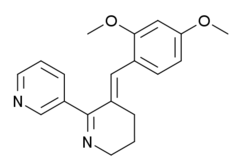GTS-21
 | |
| Clinical data | |
|---|---|
| Other names | 3-(2,4-dimethoxy-benzylidene)anabaseine |
| Identifiers | |
| |
JSmol) | |
| |
| |
| (verify) | |
This article needs to be updated. (April 2015) |
GTS-21 (DMXBA or DMBX-anabaseine) is a drug that has been shown to enhance memory and cognitive function. It has been studied for its potential therapeutic uses, particularly in the treatment of neurodegenerative diseases and psychiatric disorders.
It is a derivative of the natural product anabaseine that acts as a partial agonist at neural nicotinic acetylcholine receptors (nAChRs). It binds to both the α4β2 and α7 subtypes, but activates only the α7 to any significant extent.[1][2] Activation of the α7 nAChR has been shown to have neuroprotective effects and to improve cognitive function, making it an attractive target for drug development.
Both GTS-21 itself and its demethylated active metabolite 4-OH-GTS-21
Animal studies
Several studies have investigated the effects of GTS-21 in various animal models of neurodegenerative diseases, including Alzheimer's disease, Parkinson's disease, and multiple sclerosis. In these studies, GTS-21 has been shown to have anti-inflammatory and neuroprotective effects, and to improve cognitive function.
A recent study investigated the cholinergic anti-inflammatory pathway (CAP) in rheumatoid arthritis (RA). They used the α7 nicotinic acetylcholine receptor (α7nAChR) agonist GTS-21 to study its role in reducing synovial inflammation in a mice model of collagen-induced arthritis (CIA). GTS-21 lessened inflammation and reduced monocyte infiltration into the synovium. This study highlights a new mechanism by which cholinergic signaling can mitigate synovial inflammation in RA.[17]
Clinical trials
Phase one of a clinical trial using DXMBA as a potential treatment for schizophrenia was completed in January of 2005. 12 non-smoking subjects diagnosed with schizophrenia each received 3 daily treatments. The treatments consisted of 150mg of DMXBA, with another dose of 75mg administered 2 hours later, 75mg of DXMBA, with another dose of 37.5mg administered 2 hours later, and a placebo treatment. The order of the doses was randomized over the 3-day course of the treatments. A P50 auditory-evoked test measured a significant effect on sensory gating, and a Repeatable Battery for Assessment of Neuropsychological Status test measured a significant effect on neurocognition. The subjects did not report any symptoms or side effects, however the leukocyte count of one subject decreased from slightly above normal on the placebo, to slightly below normal when administered the higher dose of DXMBA. After receiving no exposure to the drug, the subject's leukocyte count returned to normal 2 days later.[18] This clinical trial untimely was discontinued during phase II.[18] Several other trials focusing on a range of health issues including Alzheimer's, schizophrenia, autism, ADHD, and nicotine use were either discontinued or withdrawn.[19][20][21][22][23]
Another study of GTS-21 in healthy volunteers found that the drug improved attention and memory performance.[4]
Overall, the available evidence suggests that GTS-21 has potential as a therapeutic agent for neurodegenerative diseases and psychiatric disorders. However, more research is needed to fully understand its safety and efficacy, and to determine the optimal dosing and administration regimens.
History
The laboratory name GTS-21 means that it is the 21st chemical compound created by Gainesville (University of Florida in Gainesville) and Tokushima (Taiho Pharmaceutical) Scientists.[24] DMXBA – 3-2,4-dimethoxybenzylidene anabaseine.
References
- S2CID 205923953.
- S2CID 13104716.
- PMID 9864273.
- ^ PMID 12629535.
- S2CID 325503.
- S2CID 54342132.
- S2CID 41950110.
- PMID 14693263.
- PMID 10456692.
- S2CID 39523754.
- S2CID 219187104.
- PMID 12769624.
- S2CID 21557412.
- PMID 16754836.
- PMID 17714692.
- PMID 18381905.
- PMID 37481853.
- ^ a b Clinical trial number NCT00100165 for "Phase 2 Trial of the Nicotinic Agonist 3-(2,4 Dimethoxybenzylidene Anabaseine) in Schizophrenia " at ClinicalTrials.gov
- ^ Clinical trial number NCT00414622 for "GTS21-201 for Alzheimer Disease:GTS-21 Administered Daily for 28 Days to Participants With Probable Alzheimer's Disease" at ClinicalTrials.gov
- ^ Clinical trial number NCT01400477 for "Nicotinic Receptors and Schizophrenia" at ClinicalTrials.gov
- ^ Clinical trial number NCT02111551 for "Phase I Nicotinic Agonist Treatment Trial for Autism" at ClinicalTrials.gov
- ^ Clinical trial number NCT00419445 for "Safety and Efficacy of GTS21 in Adults With Attention-deficit Hyperactivity Disorder" at ClinicalTrials.gov
- ^ Clinical trial number NCT02432066 for "Effects of GTS-21 on Smoking Behavior and Neurocognitive Functions" at ClinicalTrials.gov
- PMID 3663414.
Further reading
- Levin ED, McClernon FJ, Rezvani AH. "Effects of oral nicotine and GTS-21 (DMXB-A) on working memory in smokers". Psychopharmacology. 194 (2): 173–181.
